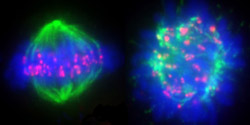Capturing Chromosomes during Cell Division

Spindle apparatus (left): Aurora B regulates the Ska complex. The chromosomes (blue) can be captured by the spindle fibres (green) at the attachment points (red). Spindle apparatus (right): Aurora B can’t regulate the Ska complex. Aurora B can’t fix the attachment points (red) between chromosomes (blue) and spindle fibres (green). (Photo: University of Basel)<br>
Dr. Ying Wai Chan and Dr. Anna Santamaria, scientists from Prof. Erich Nigg’s research group, have been able to show that the enzyme Aurora B and the protein complex Ska play a central role in flawless chromosome segregation. These findings, also relevant to cancer research, have now been published in the current issue of «Journal of Cell Biology».
The human body grows by cells dividing and multiplying. In this highly complex process, flaws may occur, which are responsible for the development of tumor cells. To ensure the error-free division of the cell, the genetic material of the cell – consisting of 23 pairs of chromosomes – must be divided evenly into two new daughter cells.
Prof. Erich Nigg’s research group has been able to show how the enzyme Aurora B, important for cell proliferation, ensures the error-free separation of the chromosomes. Aurora B regulates the interaction between two protein complexes (Ska complex and KMN complex) with the spindle apparatus, the molecular machine that drives cell division.
Aurora B determines the point in time and tensile strength
During cell division, the spindle apparatus produces spindle fibres. They reach out from two poles and each attaches to one sister chromosome. These are then pulled apart in opposite directions and incorporated into two daughter cells. “How the spindle fibre attaches to a chromosome is critical for the whole process“, explains Dr. Anna Santamaria. She and her co-workers have investigated the mechanism regulating how chromosomes get captured by the spindle fibres. The team found that, by regulating the protein complex Ska, the enzyme Aurora B determines the strength of the bond as well as the timing for optimal adhesion of the spindle fibres. Both must be exactly right to ensure that all sister chromosomes are correctly transferred to the two new daughter cells.
Tumor cells through errors in cell division
Should an error occur in this control mechanism, it could result in a chromosome being mis-segregated. Such cells could then develop into tumor cells and lead to cancer. Hence, the findings offer also insights which may lead to new approaches in cancer research. In collaboration with Prof. Elena Conti’s research group at the Max Planck Institute for Biochemistry in Martinsried, Erich Nigg’s team is concentrating its efforts on elucidating the structure of the Ska complex. The results so far look very promising and this spring another publication is expected.
Original article
Ying Wai Chan, A. Arockia Jeyaprakash, Erich A. Nigg, and Anna Santamaria
Aurora B controls kinetochore–microtubule attachments by inhibiting Ska complex–KMN network interaction
J Cell Biol, Published online February 27, 2012. doi:10.1083/jcb.201109001
Contact
Prof. Dr. Erich Nigg, Biozentrum der Universität Basel, Tel. +41 61 267 16 56 (direkt), Tel. 41 61 267 20 66 (Sekretariat), E-Mail: erich.nigg@unibas.ch
Media Contact
All latest news from the category: Life Sciences and Chemistry
Articles and reports from the Life Sciences and chemistry area deal with applied and basic research into modern biology, chemistry and human medicine.
Valuable information can be found on a range of life sciences fields including bacteriology, biochemistry, bionics, bioinformatics, biophysics, biotechnology, genetics, geobotany, human biology, marine biology, microbiology, molecular biology, cellular biology, zoology, bioinorganic chemistry, microchemistry and environmental chemistry.
Newest articles

A universal framework for spatial biology
SpatialData is a freely accessible tool to unify and integrate data from different omics technologies accounting for spatial information, which can provide holistic insights into health and disease. Biological processes…

How complex biological processes arise
A $20 million grant from the U.S. National Science Foundation (NSF) will support the establishment and operation of the National Synthesis Center for Emergence in the Molecular and Cellular Sciences (NCEMS) at…

Airborne single-photon lidar system achieves high-resolution 3D imaging
Compact, low-power system opens doors for photon-efficient drone and satellite-based environmental monitoring and mapping. Researchers have developed a compact and lightweight single-photon airborne lidar system that can acquire high-resolution 3D…





















